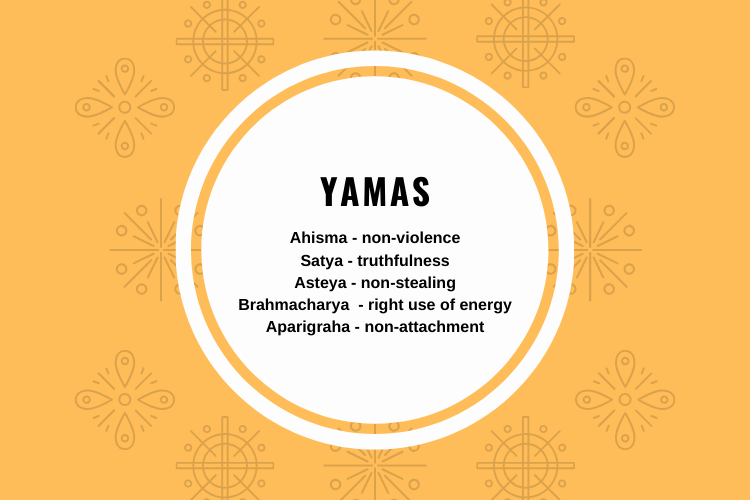
8 Limbs of Yoga – Part 1 – YAMA
Written by Vidya Venkateswaran
Yoga is traditionally divided into eight limbs: Yama, Niyama, Asana, Pranayama, Pratyahara, Dharana, Dhyana, and Samadhi. The first two limbs Yama and Niyama are the social and individual ethical constructs of the eight limbs.

Yamas can be likened to a set of moral values that guide our interaction with the world around us. The five yamas are: Ahimsa, Satya, Asteya, Brahmacharya, and Aparigraha. According to B.K.S. Iyengar, “the observance of the yama discipline the five organs of action which are the arms, the legs, the mouth, the organs of generation, and the organs of excretion.”
Ahimsa
- The first and most important yama is Ahimsa which means non-violence. Ahimsa implies that we live in a way that causes no harm in thought, speech, or action to any living being including ourselves or others.
- Ahimsa entreats us to adopt a positive mindset to all things we do, bringing awareness to our thoughts and actions.
- In our daily life we can adopt Ahimsa by being more mindful, less judgemental, and kind with ourselves and others.
- In our yoga practice we can incorporate Ahimsa by being gentle in our practice, patient with ourselves and listening to our bodies. This yama is about creating a sustainable practice with boundaries.
Satya
- Satya literally translates to truthfulness.
- In our everyday life it means to be present with our current state at any given moment; being able to embody our thoughts, ideas, and emotions. This yama is about being genuine and authentic. It is about asking honest questions to help lead you to your higher purpose.
- On the mat, Satya is reflected in our ability to be true and honest in our practice. It is also about using both sides of the body equally and being accepting of our practice just the way it is.
Asteya
- The word Asteya translates to the abstinence of stealing. At a deeper level Asteya means relinquishing the desire to possess or steal anything, may it be success, material gain, etc. that isn’t ours. This desire arises from a poor sense of self worth, greed or constant comparison with others.
- In our daily lives we can develop abundance through a spirit of generosity and by being of service. We should be grateful and appreciative of our uniqueness because there is only one us.
- On the mat, we practice Asteya by setting boundaries, being respectful of the class and of our peers. It’s important to remember to practice gratitude for our yoga practice and refrain from being competitive or judgemental of our fellow yogis.
Brahmacharya
- This yama is often misinterpreted as celibacy. It can be interpreted as a way of living that connects us with the divine.
- Brahmacharya is realizing that happiness and contentment is within us.
- In our daily lives it is about slowing down for a few moments to connect with our breath. It is about listening to our body and responding in a meaningful way. It is about nourishing the body with good quality food and the mind with positive thoughts and affirmations.
- On the mat, we achieve this by practicing asanas in a balanced manner where body and breath become one and we feel recharged.
Aparigraha
- Aparigraha focuses on not hoarding and not accumulating.
- This yama teaches us to take only as much as we need, and let go of what we don’t require any more.
- In our life we can practice Aparigraha by doing what needs to be done without concern of the reward. We do things to the best of our ability without expectation. We practice not hoarding and shopping only as much as we need.
- On the mat, we practice this yama by knowing that as we maintain a sincere practice we will grow physically, mentally and spiritually.
In conclusion, this limb of yoga is vital to be a fulfilling, energetic being, both as a yogi and as a person. By integrating the values of Ahimsa, Satya, Asteya, Brahmacharya, and Aparigraha, not only do we better ourselves but the world around us.




No Comments